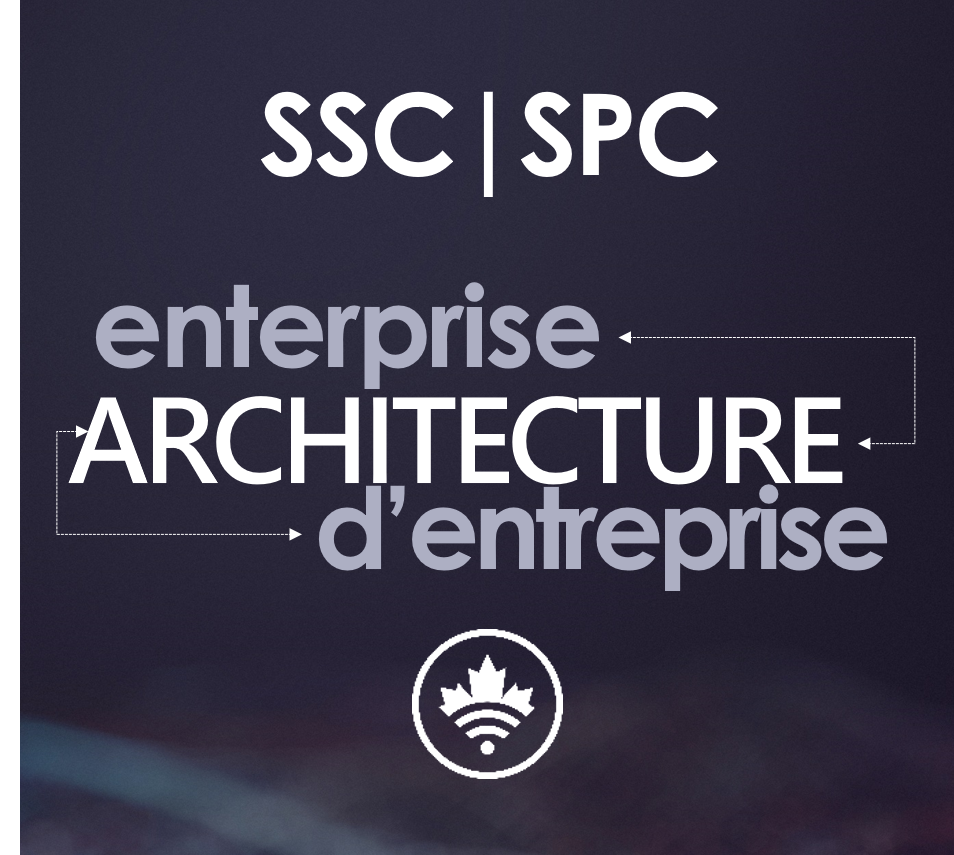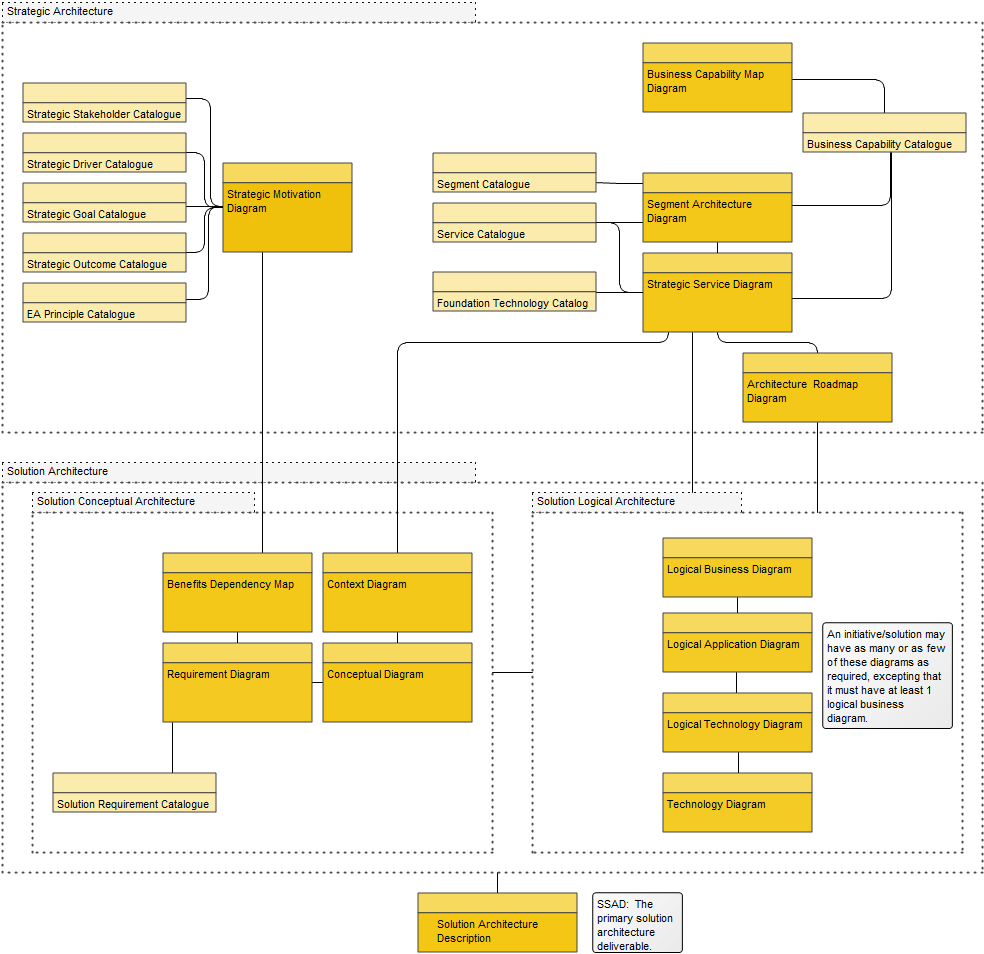SSC Artifacts and Diagrams
In addition to a content metamodel, SSC has established a set of specific artifacts (catalogs, matrices, diagrams) that are required. In general, these artifacts follow the recommended viewpoints established in the ArchiMate 3.0.1 Specification. However, in some instances we have chosen diagrams that better suit our particular needs, particularly in respect to project and service governance. The following are the required and recommended artifacts for architecture at SSC.
SSC Key EA Artifacts Diagram
Strategic Architecture
This portion of enterprise architecture contains artifacts that define the scope of the enterprise, break it down into useful portions (segments), describe the strategic current/target states, drivers and motivations.
Strategic Motivation Diagram
Prepared by: Benefits Management.
Purpose/Value: Used to identify and related the strategic drivers, goals, outcomes of the organization, and the key strategic stakeholders. Provides links to identify what existing and planned architecture are supporting the enterprise's desired target direction. All solution architectures should link (directly or indirectly) to a strategic goal or outcome.
Scope/Constraints: None beyond the constraints of the default ArchiMate 3.0 recommended viewpoint.
Key Stakeholders: Enterprise architects, business analysts, strategic planning, benefits realization, SSC executives.
Based on ArchiMate Viewpoint: Motivation Viewpoint
Business Capability Map
Purpose/Value: A primary communication mechanism with SSC executives on the state of the architecture, activities, and progress towards desired target direction. Helps ensure alignment between current/target activities and the strategic direction/capabilities of the organization. Investment prioritization.
Prepared by: Enterprise Architecture - Business Capability Lead
Scope/Constraints: Generally limited to identifying capabilities/sub-capabilities, and their association with enterprise strategic outcomes, goals, drivers.
Key Stakeholders: Senior executives, branches, business managers, enterprise and business architects. Investment prioritization.
Based on ArchiMate Viewpoint: Capability Map
Segment Diagram
Prepared by: Enterprise Architect - Segment Architect/Lead
Purpose/Value: Enables EA to organize, prioritize and assign architecture work/activities. In particular, it identifies the segments that will be used to organize EA work, and distributes the key services/functions among them. Every identified SSC service should belong to a segment.
Scope/Constraints: Uses only business roles, business actors, and business functions with categories "SSC Segment", "SSC Client-facing Service", and "SSC Supporting Service". It may begin to associate key high-level roles, information, applications - but generally, it leaves details of architecture to dedicated lower-level diagrams. One diagram per defined segment.
Key Stakeholders: Enterprise architects/Enterprise Architecture management/executives.
Based on ArchiMate Viewpoint: Business Process Cooperation Viewpoint
Strategic Service Diagram
Prepared by: Enterprise Architect (in collaboration with Service Leads/Architects)
Purpose/Value: Provides a conceptual view of SSC Services, key inter-service linkages, strategic linkages, and links to enabling technologies. Answers the questions: 1) What services/functions need which services to operate?, 2) What technologies are required by a particular SSC Service?
Scope/Constraints: This diagram defines, at a high level, an SSC service. It links the SSC Service to Business Capabilities (1 or more), and to other key business functions/services, and to the key foundational/supporting technologies. The diagram may expose some of the key sub-functions/processes that are performed in that SSC service (down 1 level of conception). Detailed business, application, information and technology diagrams for a particular service are to be detailed in other (solution-level) diagrams.
Key Stakeholders: Enterprise architects/Enterprise Architecture management/executives, Service architects.
Strategic Service Diagram Guidance (QW login required)
Strategic Service Diagram Example (QW login required)
Based on ArchiMate Viewpoint: Layered Viewpoint
Architecture Roadmap Diagram
Prepared by: Enterprise Architect (in collaboration with Service Leads/Architects)
Purpose/Value: Defines/describes the different architectures for a particular service in defined states (n-2, n-1, n, n+1, n+2) and plateaus (current, target, target+), and what work packages (projects) will satisfy which identified architecture gaps.
Scope/constraints: Uses Implementation and Migration elements, and Motivation elements (goal/outcome).
Key Stakeholders: Enterprise Architects, Service Architects, Solution Architects, Service leads/teams.
Architecture Roadmap Demonstration Video
Based on ArchiMate Viewpoint: Layered Viewpoint
Solution (including Service) Architecture
These diagrams are for service or solution architectures for initiatives. The solution architecture artifacts are usually captured in a Service and Solution Architecture Description deliverable (package). These solution architectures are reviewed with enterprise architecture through a governance processes (architecture assurance) to help ensure alignment with the enterprise architecture.
Conceptual Solution Architecture
Requirements Diagram
Prepared by: Solution architect, service architect.
Purpose/Value: List and definitions of the requirements for a project/initiative, as well as any related/influencing standards, principles, policies and/or reference architectures.
Key Stakeholders: Project managers, project teams, business analyst, business architects, service architects, solution architects, engineers.
Based on ArchiMate Viewpoint: Motivation Viewpoint
Benefits Dependency Map
Prepared by: Benefits management (in cooperation with the project/service team and/or service/solution architect)
Purpose/Value: Identify the benefits of a projects/initiative, identifying key performance metrics (KPI's) that will be used to measure success of the effort. Helps ensure alignment with enterprise outcomes, identify and link requirements to tactical and strategic outcomes.
Scope/Constraints: Uses motivation elements of outcomes and implementation & migration element of work package and deliverable.
Key Stakeholders: Project manager/lead, project team, business analyst, benefits realization team, governance bodies, management, executives.
Benefits Dependency Map Demonstration Video
Based on ArchiMate Viewpoint: Motivation Viewpoint
Context Diagram
Prepared by: Service/Solution architect
Purpose/Value: Identifies the services used and/or modified/created by the initiative. Identifies and links the initiative to a business capability to be fully or partly realized by the initiative.
Key Stakeholders: Enterprise Architect, Governance Bodies (EART, AC, SARB).
Conceptual Diagram
Prepared by: Service/Solution architect
Purpose/Value: Identifies what, at a high/conceptual level, this project/initiative intends to do (key/main functions), for which clients (roles/actors), and what key information will be required/managed.
Scope/Constraints: Show no sequence/flow, and generally no associations. Limited to actors, roles, business functions (key high-level), business information, key application components, system software, technology services.
Key Stakeholders: Governance bodies (particularly AC and ESSARB), project teams/leads/managers, executives, enterprise architects, service architects, solution architects.
ArchiMate Viewpoint: Layered Viewpoint
Logical (and sometimes physical) Architecture
Logical Business Diagram (mandatory)
Prepared by: Service/Solution architect
Purpose/Value: Identifies/defines the business (functions, processes, roles, actors, etc...) of the project/initiative/SSC service, and links to application/data/information layers.
Scope/Constraints: May only use application components from the application layer. May have 1 diagram, or as many in as much detail as is required for the initiative.
Key Stakeholders: Governance bodies (particularly AC and ESSARB), project teams/leads/managers, enterprise architects, service architects, solution architects, business leads, business architects, business analists, business process practicioners.
ArchiMate Viewpoint: Business Process Cooperation Viewpoint
Logical Application Diagram
Prepared by: Service/Solution architect
Purpose/Value: Optional. Used if more details on application or inter/intra-application are required. Focus on application development/components specifically.
Scope/Constraints: Must link applications to business processes/functions as defined in the logical business diagram. Diagram is optional, and is only needed if required to define the application and/or data architecture for the initiative. Can have as many as are required.
Key Stakeholders: Application managers, application architects, service architects, solution architects, CIO office, project team, application developers.
ArchiMate Viewpoint: Application Cooperation Viewpoint
Logical Technology (Usage) Diagram
Prepared by: Service/Solution architect
Purpose/Value: Maps applications/application systems to required (generic/high level) technology implementations.
Scope/Constraints: Must link the diagram (with objects within the diagram) to either a logical application diagram (and/or objects), or a logical business diagram (or functions/processes therein). Optional. Many have as many as is required to define the technology architecture to the level of detail desired.
Key Stakeholders: Service architects, solution architects, engineers, designers, implementers, operations staff, application support staff and management.
ArchiMate Viewpoint: Technology Usage Viewpoint
Logical Technology Diagram
Prepared by: Service/Solution architect
Purpose/Value: Identifies/defines the required technology components, positioning/placement/location, relationships, network, network zoning required for the initiative.
Scope/Constraints: None.
Key Stakeholders: Service architects, solution architects, engineers, designers, implementers, operations staff.
ArchiMate Viewpoint: Technology Viewpoint
Reference Library
The reference library contains a number of catalogues managing objects to be used across all levels of architecture. It particularly houses links to objects representing IT Standards and reference architectures (patterns). r
Reference Architecture Catalog
Prepared/maintained by: Enterprise Architecture
Key Stakeholders: Enterprise architects, service architects, solution architects, engineers/implementers.
Purpose/Value: Provides a list of the reference architecture documents available, informing architects of the standard patterns and considerations for preparing architecture in particular defined circumstances.
Reference Architecture Diagram
Prepared by: Enterprise architect, solution/service architect, subject matter experts.
ArchiMate Viewpoint: Layered Viewpoint
Scope/Constraints: None.
Key Stakeholders: Enterprise architects, service architects, solution architects, engineers/implementers.
Purpose/Value: Diagrams of reference architecture patterns/options, to illustrate patterns and considerations for preparing new architectures under particular defined conditions/circumstances. Used to ensure alignment/compliance and consistency of implementations.
IT Standard Catalog
Prepared/Maintained by: Enterprise Architecture
Key Stakeholders: Enterprise architects, service architects, solution architects, engineers/implementers.
Purpose/Value: Provides a list of IT Standards to be applied to architectures, designs and implementations at SSC. Used to ensure alignment/compliance and consistency of implementations.
Content Metamodel Diagram
Prepared/maintained by: Enterprise Architecture
ArchiMate Viewpoint: Layered Viewpoint
Scope/Constraints: None.
Key Stakeholders: Enterprise architects, service architects, solution architects, engineers/implementers.
Purpose/Value: Illustrates the valid relationships amongst all types of architecture objects, and the rules to be applied for their use in architecture models. The model of the model for architecture.
Lexicon Catalog
Prepared/maintained by: Enterprise Architecture
Key Stakeholders: All users and practitioners of architecture.
Purpose/Value: Provides definitions of terms/nomenclature used for architecture.
Initiative (Project) Catalog
Prepared/maintained by: Enterprise architecture, governance body secretariats, others.
Key Stakeholders: Executives, project managers/leads, project teams, enterprise architects, service architects, solution architects, governance bodies, engineers.
Purpose/Value: Used to associate objects, artifacts, deliverables to particular projects/initiatives.
Architecture Gaps Catalog
Prepared/maintained by: Enterprise Architecture
Key Stakeholders: Enterprise Architecture, Service/solution architects, SISD, Service Lines
Purpose/Value: To identify SSC gaps so that they may be accommodated in future architecture and initiatives.

